
Creative Commons Attribution-Noncommercial-No Derivative Works 3.0
Plates 3.33-3.37: Six Views of Cowdray House (Original Explanatory Account)
1 media/vm1-02-cropped.jpg 2020-08-09T00:13:57+00:00 Quanah Leija-Elias fc578bb41a53b12f2a08253bc8cc52547b2ff8bb 31 84 Original Explanatory Account for Vetusta Monumenta, Plates 3.33-3.37. Written by Richard Gough. plain 2023-01-11T22:10:28+00:00 Mary-Claire Sarafianos b64b0f9cad2b567cca4c9f2022b28f5bd47876a6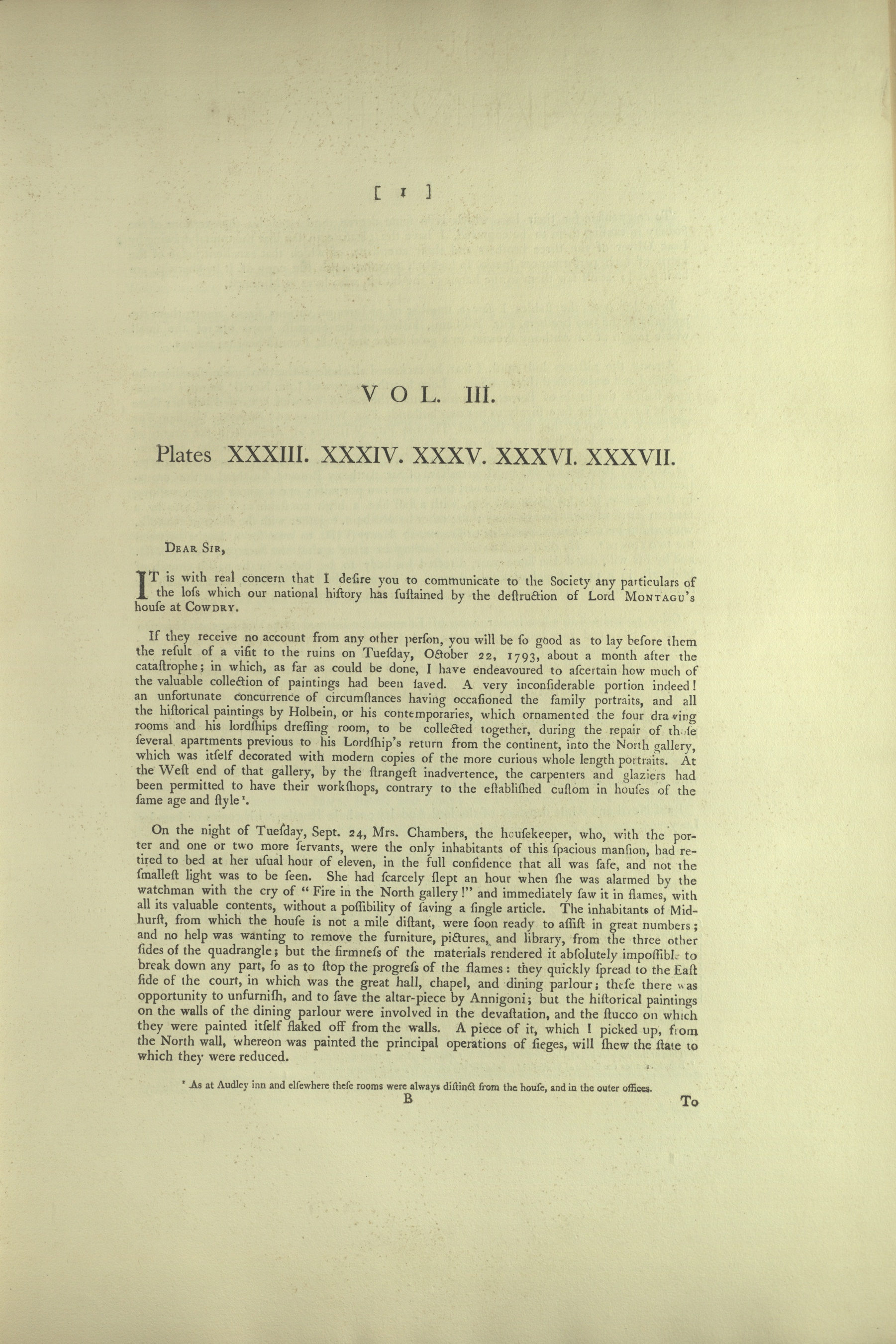
[ (Page) 1 ]
VOL. III. Plates XXXIII. XXXIV. XXXVI. XXXVII.
Dear Sir, IT is with real concern that I desire yo to communicate to the Society any particulars of the loss which our national history has sustained by the destruction of Lord MONTAGU’s house at COWDRY.
Read more/less...
If they receive no account from any other person, you will be so good as to lay before them the result of a visit to the ruins of Tuesday, October 22, 1793, about a month after the catastrophe; in which, as far as could be done, I have endeavored to ascertain how much of the valuable collection of paintings had been saved. A very inconsiderable portion indeed! An unfortunate concurrence of circumstances having occasioned the family portraits, and all the historical paintings by Holbein, or his contemporaries, which ornamented the four drawing rooms and his lordships dressing room, to be collected together, during the repair of those several apartments previous to his Lordship’s return from the continent, into the North gallery, which was itself decorated with modern copies of the more curious whole length portraits. At the West end of that gallery, by the strangest inadvertence custom in houses of the same age and style1.
On the night of Tuesday, Sept. 24, Mrs. Chambers, the housekeeper, who, with the porter and one or two more servants, were the only inhabitants of this spacious mansion, had retired to bed at her usual hour of eleven, in the full confidence that all was safe, and not the smallest light was to be seen. She had scarcely slept an hour when she was alarmed by the watchman with the cry of “Fire in the North gallery!” and immediately saw it in flames, with all its valuable contents, without possibility of saving a single article. The inhabitants of Midhurst, from which the house is not a mile distant, were soon ready to assist in great numbers; and no help was wanting to remove furniture, pictures, and library, from the three other sides of the quadrangle; but the firmness of the materials rendered it absolutely impossible to break down any part, so as to stop the progress the flames: they quickly spread to the East side of the court, in which was the great hall, chapel, and dining parlour; these there was opportunity to unfurnish, and to save the altar-piece by Annigoni; but the historical paintings on the walls of the dining parlour were involved in the devastation, and the stucco on which they were painted itself flaked off from the walls. A piece of it, which I picked up, from the North wall, whereon was painted the principal operations of sieges, will shew the state to which they were reduced.
1 As at Audley inn and elsewhere these rooms were always distinct from the house, and in the outer offices.
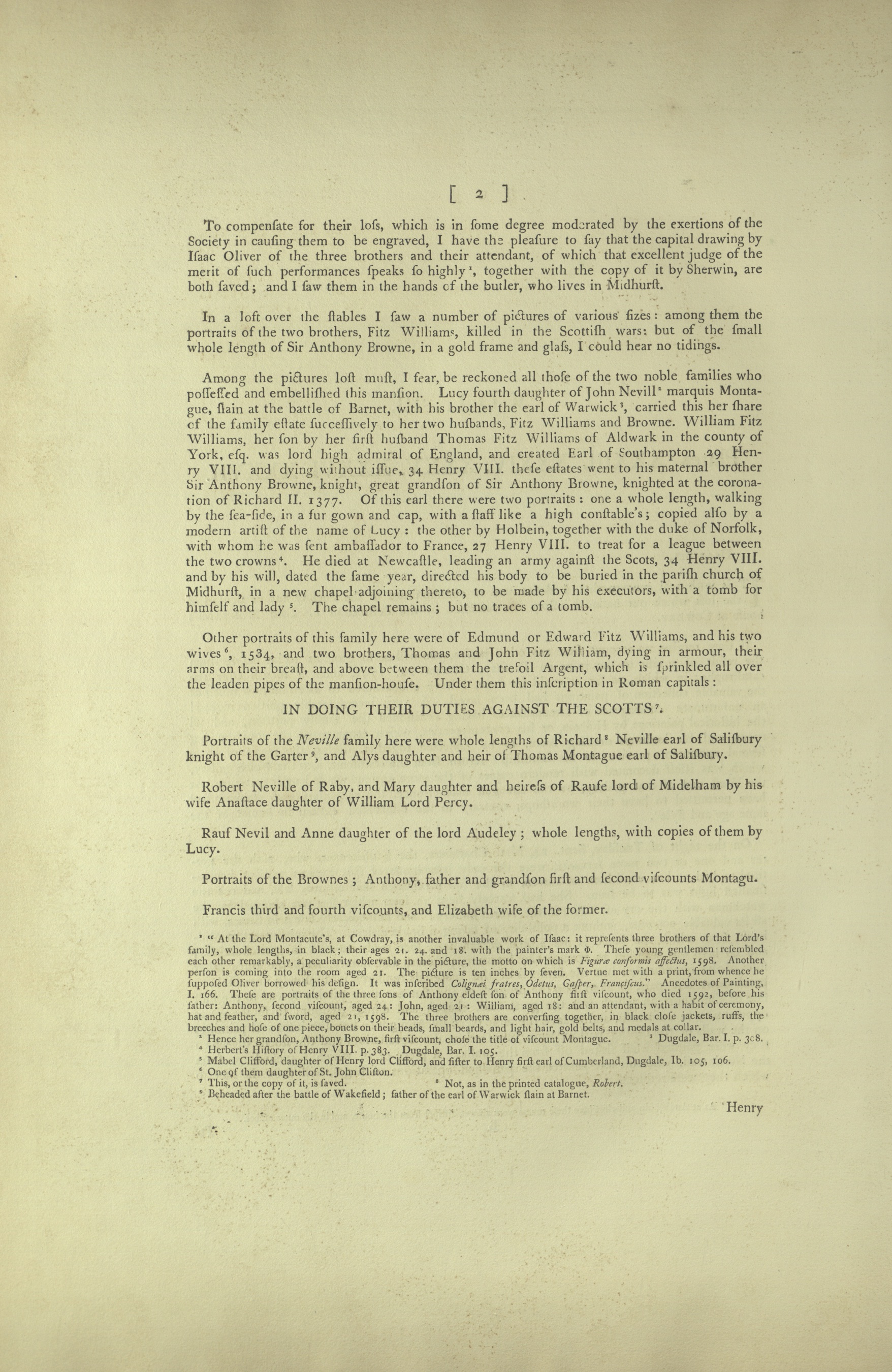
[ (Page) 2 ]
To compensate for their loss, which is in some degree moderated by the exertions of the Society in causing them to be engraved, I have the pleasure to say that the capital drawing by Isaac Oliver of the three brothers and their attendant, of which that excellent judge of the merit of such performances speaks so highly1, together with the copy of it by Sherwin, are both saved; and I saw them in the hands of the butler, who lives in Midhurst.
Read more/less...
In a loft over the stables I saw a number of pictures of various sizes : among them the portraits of the two brothers, Fitz Williams, killed in the Scottish wars: but of the small whole length of Sir Anthony Browne, in a gold frame and glass, I could hear no tidings.
Among the pictures lost must, I fear, be reckoned all those of the two noble families who possessed and emblellished this mansion. Lucy fourth daughter of John Nevill2 marquis Montague, slain at the battle of Barnet, with his brother the earl of Warwick3, carried this her share of the family estate successively to her two husbands, Fitz Williams and Browne. William Fitz Williams, her son by her first husband Thomas Fitz Williams of Aldwark in the county of York, esq. was lord high admiral of England, and created Earl of Southampton 29 Henry VIII. and dying without issue, 34 Henry VIII. these estates went to his maternal brother Sir Anthony Browne, knight, great grandson of Sir Anthony Browne, knighted at the coronation of Richard II. 1377. Of this earl there were two portraits : one a whole length, walking by the sea-side, in a fur gown and cap, with a staff like a high constable’s; copied also by a modern artist of the name Lucy : the other Holbein, together with the duke of Norfolk, with whom he was sent ambassador to France, 27 Henry VIII. to treat for a league between the two crowns4. He died at Newcastle, leading an army against the Scots, 34 Henry VIII. and by his will, dated the same year, directed his body to be buried in the parish church of Midhurst, in a new chapel adjoining thereto, to be made by his executors, with a tomb for himself and lady5. The chapel remains ; but no traces of a tomb.
Other portraits of this family here were of Edmund or Edward Fitz Williams, and his two wives6, 1534, and two brothers, Thomas and John Fitz William, dying in armour, their arms on their breast, and above between them the trefoil Argent, which is sprinkled all over the leaden pipes of the mainsion-house. Under them this inscription in Roman capitals:
IN DOING THEIR DUTIES AGAINST THE SCOTTS7.
Portraits of the Neville family here were whole lengths of Richard8 Neville earl of Salisbury knight of the Garter9, and Alys daughter and heir of Thomas Montague earl of Salisbury.
Robert Neville of Raby, and Mary daughter and heiress of Raufe Lord of Midelham by his wide Anastace daughter of William Lord Percy.
Rauf Nevil and Anne daughter of the lord Audeley ; whole lengths, with copies of them by Lucy.
Portraits of the Brownes ; Anthony, father and grandson first and second viscounts Montagu.
Francis third and forth viscounts, and Elizabeth wife of the former.
1 “At the Lord Montacute’s, at Cowdray, is another invaluable work of Isaac: it represents three brothers of that Lord’s family, whole lengths, in black ; their ages 21, 24 and 18. with the painter's mark Φ. These young gentlemen resembled each other remarkably, a peculiarity observable in the picture, the motto on which is Figurae conformis affectus [affect conforming to figure], 1598. Another person is coming into the room aged 21. The picture is ten inches by seven. Vertue met with a print, from whence he supposed Oliver borrowed his design. It was inscribed Colignaei fratres, Odetus, Gasper, Franciscus [Brothers of Cologne, Odetus, Gasper, Franciscus].” Anecdotes of Painting, I. 166. These are portraits of the three sons of Anthony eldest son of Anthony first viscount, who died 1592, before his father: Anthony, second viscount, aged 24: John, aged 21: William, aged 18: and an attendant, with a habit of ceremony, hat and feather, and sword, aged 21, 1598. The three brothers are conversing together, in black close jackets, ruffs, the breeches and hose of one piece, bonnets on their heads, small beards, and light hair, gold belts, and medals at collar.
2 Hence her grandson, AnthonyBrowne, first viscount, chose the title of viscount Montague.
3 Dugdale, Bar. I. p. 308.
4 Herbert’s History of Henry VIII. p. 383. Dugdale Bar. I. 105.
5 Mabel Clifford, daughter of Henry lord Clifford, and sister to Henry first earl of Cumberland, Dugdale, Ib. 105, 106.
6 One of them daughter of St. John Clifton.
7 This, or the copy of it, is saved.
8 Not, as in the printed catalogue, Robert.
9 Beheaded after the battle of Wakefield; father of the earl of Warwick slain at Barnet.
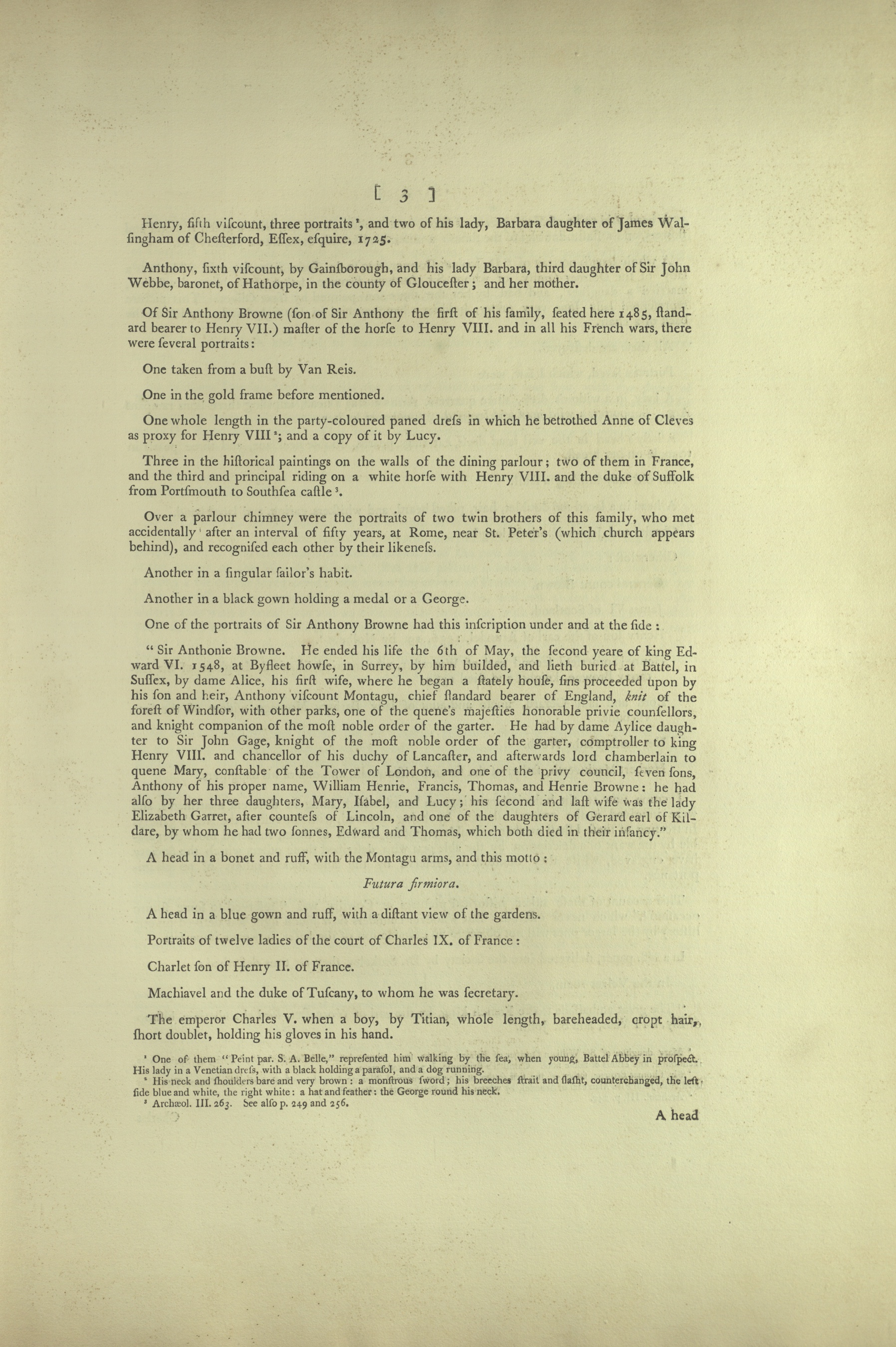
[ (Page) 3 ]
Henry, fifth viscount, three portraits1, and two of his lady, Barbara daughter of James Walsingham of Chesterford, Essex, esquire, 1725.
Read more/less...
Anthony, sixth viscount, by Gainsborough, and his lady Barbara, third daughter of Sir John Webbe, baronet, of Hathorpe, in the county of Gloucester; and her mother.
Of Sir Anthony Browne (son of Sir Anthony the first of his family, seated here 1485, standard bearer to Henry VII.) master of the horse to Henry VIII. and in all his French wars, there were several portraits:
One taken from a bust by Van Reis.
One in the gold frame before mentioned.
One whole length in the party-colored paned dress in which he betrothed Anne of Cleves as proxy for Henry VIII2; and a copy of it by Lucy.
Three in the historical paintings on the walls of the dining parlor; two of them in France, and the third and principal riding on a white horse with Henry VIII. And the duke of Suffolk from Portsmouth to Southsea castle3.
Over a parlour chimney were the portraits of two twin brothers of this family, who met accidentally after an interval of fifty years, at Rome, near St. Peter’s (which church appears behind), and recognised each other by their likeness.
Another in a singular sailor’s habit.
Another in a black gown holding a medal or a George.
One of the portraits of Sir Anthony Browne had this inscription under and at the side:
“Sir Anthonie Browne. He ended his life the 6th of May, the second year of kind Edward VI. 1548, at Byfleet howse, in Surrey, by him builded, and lieth buried at Battel, in Suffex, by dame Alice, his first wife, where he began a stately house, sins proceeded upon by his son and heir, Anthony Montague, chief standard bearer of England, Knit of the forest of Windsor, with other parks, one of the quene’s majesties honorable privy counsellors, and knight companion of the most noble order of the garter. He had by dame Aylice daughter to Sir John Gage, knight of the most noble order of the garter, comptroller to king Henry VIII. and chancellor of his duchy of Lancaster, and afterwards lord chamberlain to quene Mary, constable of the Tower of London, and one of the privy council, seven sons, Anthony of his proper name, William Henrie, Francis, Thomas, and Henrie Browne: he had also by her three daughters, Mary, Isabel, and Lucy; his second and last wife was the lady Elizabeth Garret, after countess of Lincoln, and one of the daughters of Gerard earl of Kildare, by whom he had two sonnes, Edward and Thomas, which both died in their infancy.”
A head in a Bonet and ruff, with the Montagu arms, and this motto:
Futura firmiora.
A head in a blue gown and ruff, with a distant view of the gardens.
Portraits of twelve ladies of the court of Charles IX. of France:
Charlet son of Henry II. of France.
Machiavel and the duke of Tuscany, to whom he was secretary.
The emperor Charles V. when a boy, by Titian, whole length, bareheaded, cropt hair, short doublet, holding his gloves in his hand.
1 One of them “Peint par. S. A. Belle,” represented him walking by the sea, when young, Battel Abbey in prospect. His lady in a Venetian dress, with a black holding a parasol, and a dog running.
2 His neck and shoulders bare and very brown: a monstrous sword; his breeches strait and slasht, counterchanged, the left side blue and white, the right white: a hat and feather: the George round his neck.
3 Archaeol. III. 263. See also p. 249 and 256.
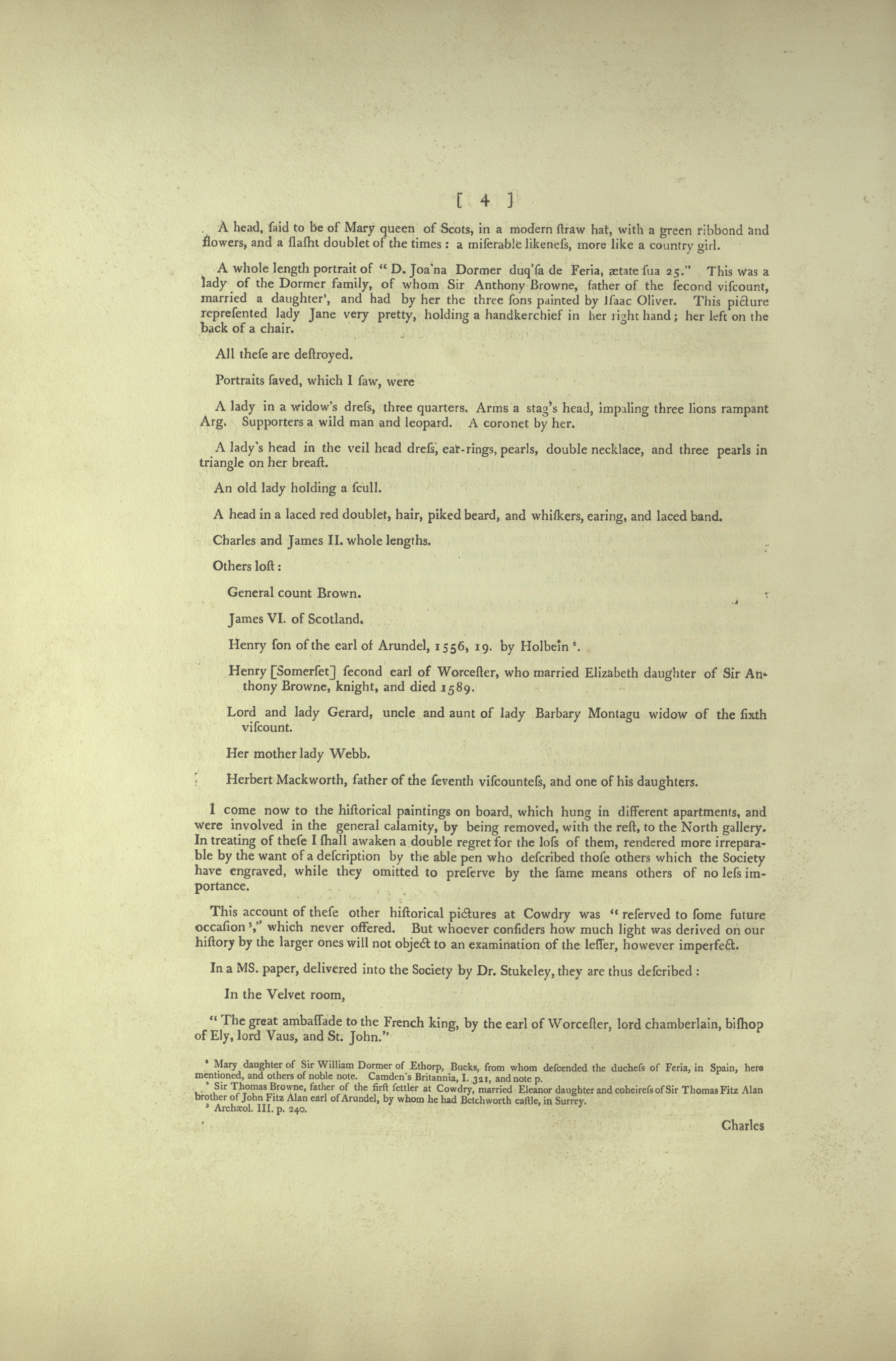
[ (Page) 4 ]
A head, said to be of Mary queen of Scots, in a modern straw hat, with a green ribbon and flowers, and a slasht doublet of the times: a miserable likeness, more like a country girl.
Read more/less...
A whole length portrait of “D. Joa’na Dormer duq’fa Feria, aetate fua 25.” This was a lady of the Dormer family, of whom Sir Anthony Browne father of the second viscount, married a daughter1, and had by her the three sons painted by Isaac Oliver. This picture represented lady Jane very pretty, holding a handkerchief in her right hand; her left on the back of a chair.
All these are destroyed.
Portraits saved, which I saw, were
A lady in a widow’s dress, three quarter. Arms a stag’s head, impaling three lions rampant Arg. Supporters a wild man and leopard. A coronet by her.
A lady’s head in the veil head dress, ear-rings, pearls, double necklace, and three pearls in triangle on her breast.
An old lady holding a scull.
A head in a laced red doublet, hair, piked beard, and whiskers, earing, and laced band.
Charles and James II. whole lengths.
Others lost:
General count Brown.
James VI. of Scotland.
Henry son of the earl of Arundel, 1556, 19. by Holbein2
Henry [Somerset] second earl of Worcester, who married Elizabeth daughter of Sir Anthony Browne, knight, and died 1589.
Lord and lady Gerard, uncle and aunt of lady Barbary Montague widow of the sixth viscount.
Her mother lady Webb.
Herbert Mackworth, father of the seventh viscountess, and one of his daughters.
I come now to the historical paintings on board, which hung in different apartments, and were involved in the general calamity, by being removed, with the rest, to the North gallery. In treating of these I shall awaken a double regret for the loss of them, rendered more irreparable by the want of a description by the able pen who described those others which the Society have engraved, while they omitted to preserve by the same means others of no less importance.
This account of these other historical pictures at Cowdry was “reserved to some future occasion3,” which never offered. But whoever considers how much light was derived on our history by the larger ones will not object to an examination of the lesser, however imperfect.
In a MS. paper, delivered into the Society by Dr. Stukely, they are thus described:
In the Velvet room,
“The great ambassade to the French king, by the earl of Worcester, lord chamberlain, bishop of Ely, lord Vaus, and St. John.”
1 Mary daughter of Sir William Dormer of Ethorp, Bucks, from whome descended the duchess of Feria, in Spain, here mentioned, and others of noble note. Camden’s Britannia, I. 321, and note p.
2 Sir Thomas Browne, father of the first settler at Cowdry, married Eleanor daughter and coheiress of Sir Thomas Fitz Alan brother of John Fitz Alan earl of Arundel, by whom he had Betchworth castle, in Surrey.
3 Archaeol. III. p. 240.
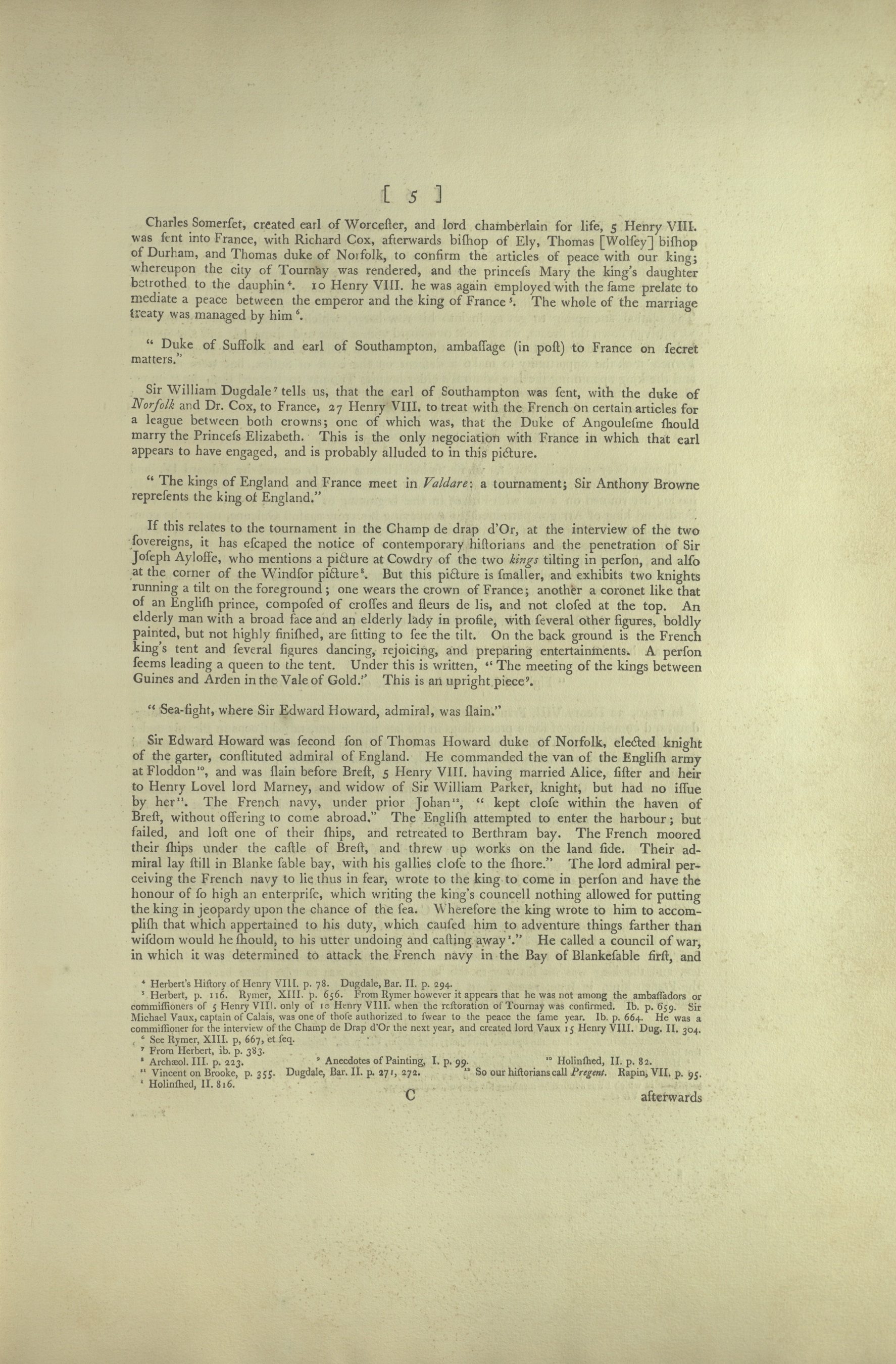
[ (Page) 5 ]
Charles Somerset, created earl of Worcester, and lord chamberlain for life, 5 Henry VIII. was sent into France, with Richard Cox, afterwards bishop of Ely, Thomas [Wolsey] bishop of Durham, and Thomas duke of Norfolk, to confirm the articles of peace with our king; whereupon the city of Tournay was rendered, and the princess Mary the king’s daughter betrothed to the dauphin. 10 Henry VIII. he was again employed with the same prelate to mediate a peace between the emperor and the king of France5. The whole of the marriage was managed by him6.
Read more/less...
“Duke of Suffolk and earl of Southampton, ambassage (in post) to France on secret matters.”
Sir William Dugdale7 tells us, that the earl of Southampton was sent, with the duke of Norfolk and Dr. Cox, to France, 27 Henry VIII. to treat with the French on certain articles for a league between both crowns; one of which was, that the Duke of Angoulesme should marry the Princess Elizabeth. This is the only negotiation with France in which that earl appears to have engaged, and is probably alluded to in this picture.
“The kings of England and France meet in Valdare: a tournament; Sir Anthony Browne represents the king of England.”
If this relates to the tournament in the Champ de trap d’Or, at the interview of the two sovereigns, it has escaped the notice of contemporary historians and the penetration of Sir Joseph Ayloffe, who mentions a picture at Cowdry of the two kings tilting in person, and also at the corner of the Windsor picture8. But this picture is smaller, and exhibits two knights running a tilt on the foreground; one wears the crown of France; another a coronet like that of an English prince, composed of crosses and fleurs de lis, and not closed at the top. An elderly man with a broad face and an elderly lady in profile, with several other figures, boldly painted, but not highly finished, are sitting to see the tilt. On the back ground is the French king’s tent and several figures dancing, rejoicing, and preparing entertainments. A person seems leading a queen to the tent. Under this is written, “The meeting of the kings between Guines and Arden in the Vale of Gold.” This is an upright piece9.
“Sea-fight, where Sir Edward Howard, admiral, was slain.”
Sir Edward Howard was second son of Thomas Howard duke of Norfolk, elected knight of the garter, constituted admiral of England. He commanded the van of the English army at Floddon10, and was slain before Brest, 5 Henry VIII. having married Alice, sister and heir to Henry Lovel lord Marney, and widow of Sir William Parker, knight, but had no issue by her11. The French navy, under prior Johan12, “kept close within the haven of Brest, without offering to come abroad.” The English attempted to enter the harbour; but failed, and lost one of their ships, and retreated to Berthram bay. The French moored their ships under the castle of Brest, and threw up works on the land side. Their admiral lay still in Blanke sable bay, with his gallies close to the shore.” The lord admiral perceiving the French navy to lie thus in fear, wrote to the king to come in person and have the honor of so high an enterprise, which writing the king’s councell nothing allowed for putting the king in jeopardy upon the chance of the sea. Wherefore the king wrote to him to accomplish that which appertained to his duty, which caused him to adventure things farther than wisdom would he should, to his utter undoing and casting away1.” He called a council of war, in which it was determined to attack the French navy in the Bay of Blankesable first, and
4 Herbert’s History of Henry VIII. p. 78. Dugdale, Bar. II. P. 294.
5 Herbert, p. 116. Rymer, XIII. p. 656. From Rymer however it appears that he was not among the ambassadors or commissioners of 5 Henry VIII. only of 10 Henry VIII. when the restoration of Tournay was confirmed. Ib. p. 664. He was a commissioner for the interview of the Champ de Drap d'Or the next year, and created lord Vaux 15 Henry VIII. Dug. II. 304.
6 See Rymer, XIII. p, 667, et feq.
7 From Herbert, ib. p. 383.
8 Archaeol. III. p. 223.
9 Anecdotes of Painting, I. p. 99.
10 Holinshed, II. p. 82.
11 Vincent on Brooke, p. 355. Dugdale, Bar. II. p. 271, 272.
12 So our historians call Pregent. Rapin, VII. p. 95.
1 Holinshed, II. 816.
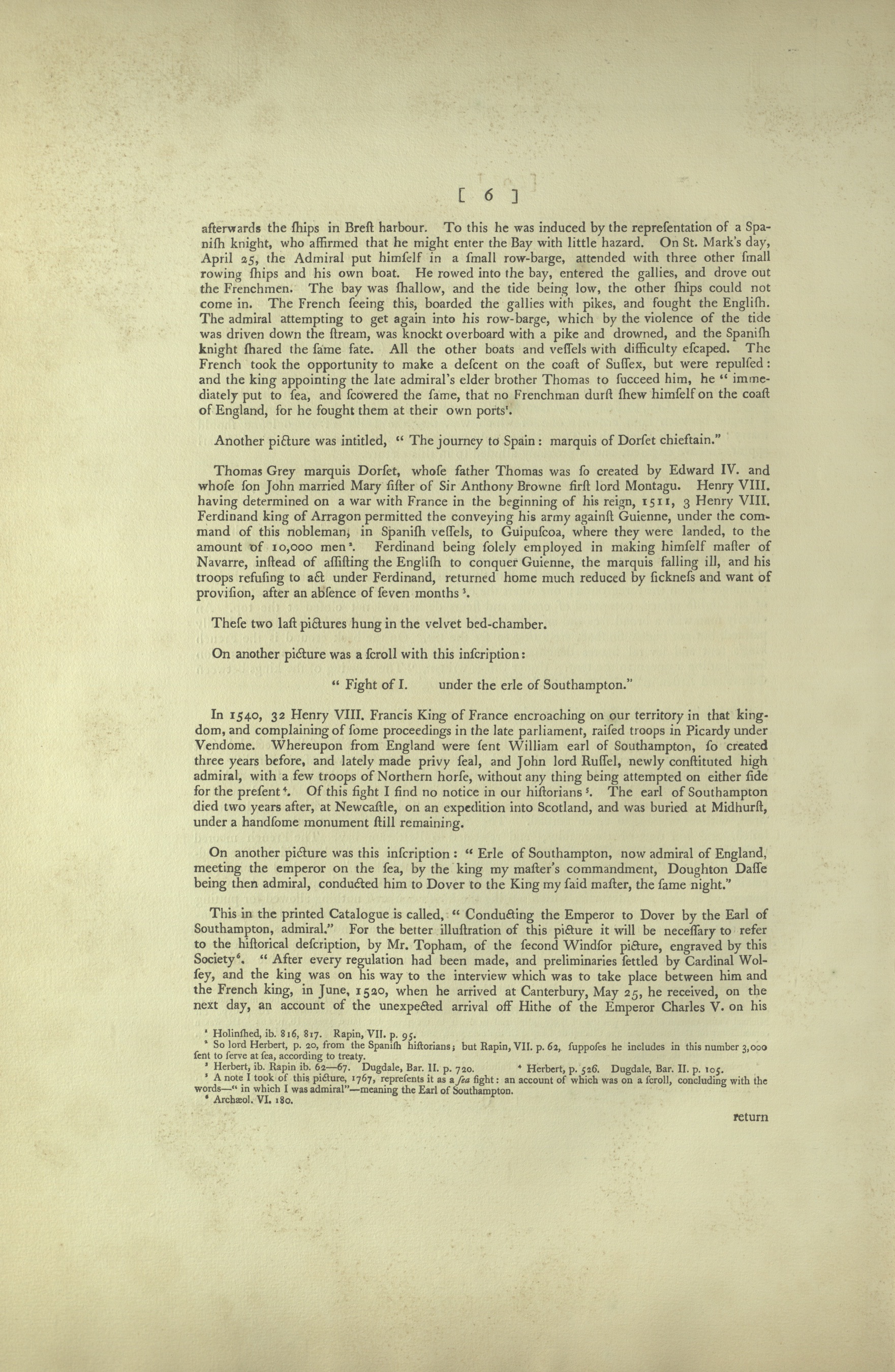
[ (Page) 6 ]
afterwards the ships in Brest harbour. To this he was induced by the representation of a Spanish knight, who affirmed that he might enter the Bay with little hazard. On St. Mark’s day, April 25, the Admiral put himself in a small row-barge, attended with three other small rowing ships and his own boat.
> Read more/less...
He rowed into the bay, entered the gallies, and drove out the Frenchmen. The bay was shallow, and the tide being low, the other ships could not come in. The French seeing this, boarded the gallies with pikes, and fought the English. The admiral attempting to get again into his row-barge, which by the violence of the tide was driven down the stream, was knockt overboard with a pike and drowned, and the Spanish knight shared the same fate. All the other boats and vessels with difficulty escaped. The French took the opportunity to make a descent on the coast of Sussex, but were repulsed: and the king appointing the late admiral’s elder brother Thomas to succeed him, he “immediately put to sea, and scoured the same, that no Frenchman durst shew himself on the coast of England, for he fought them at their own ports1.”
Another picture was intitled, “The journey to Spain: marquis of Dorset chieftain.”
Thomas Grey marquis Dorset, whose father Thomas was so created by Edward IV. and whose son John married Mary sister of Sir Anthony Browne first lord Montagu. Henry VIII. having determined on a war with France in the beginning of his reign, 1511, 3 Henry VIII. Ferdinand king of Arrogon permitted the conveying his army against Guienne, under the command of this nobleman, in Spanish vessels, to Guipuscoa, where they were landed, to the amount of 10,000 men2. Ferdinand being solely employed in making himself master of Navarre, instead of assisting the English to conquer Guienne, the marquis falling ill, and his troops refusing to act under Ferdinand, returned home much reduced by sickness and want of provision, after an absence of seven months3.
These two last pictures hung in the velvet bed-chamber.
On another picture was a scroll with this inscription:
“Fight of I. under the erle of Southampton.”
In 1540, 32 Henry VIII. Francis King of France encroaching on our territory in that kingdom, and complaining of some proceedings in the late parliament, raised in Picardy under Vendome. Whereupon from England were sent William earl of Southampton, so created three years before, and lately made privy seal, and John lord Russel, newly constituted high admiral, with a few troops of Northern horse, without any thing being attempted on either side for the present4. Of this fight I find no notice in our historians5. The earl of Southampton died two years after, at Newcastle, on an expedition into Scotland, and was buried at Midhurst, under a handsome monument still remaining.
On another picture was this inscription: “Erle of Southampton, now admiral of England meeting the emperor on the sea, by the king my master’s commandment, Doughton Dasse being then admiral, conducted him to Dover to the King my said master, the same night.”
This in the printed Catalogue is called, “Conducting the Emperor to Dover by the Earl of Southampton, admiral.” For the better illustration of this picture it will be necessary to refer to the historical description, by Mr. Topham, of the second Windsor picture, engraved by this Society6. “After every regulation had been made, and preliminaries settled by Cardinal Wolsey, and the king was on his way to the interview which was to take place between him and the French king, in June, 1520, when he arrived at Canterbury, May 25, he received, on the next day, an account of the unexpected arrival of Hithe of the Emperor Charles V. on his
1 Holinshed, ib. 816, 817. Rapin, VII. p. 95.
2 So lord Herbert, p. 20, from the Spanish historians; but Rapin, VII. p. 62, supposes he includes in this number 3,000 sent to serve at sea, according to treaty.
3 Herbert, ib. Rapin ib. 62-67. Dugdale, Bar. II. p. 720.
4 Herbert, p. 526. Dugdale, Bar. II. p. 105.
5 A note I took of this picture, 1767, represents it as a sea fight: an account of which was on a scroll, concluding with the words-“in which I was admiral”-meaning the Earl of Southampton.
6 Archaeol. VI. 180.
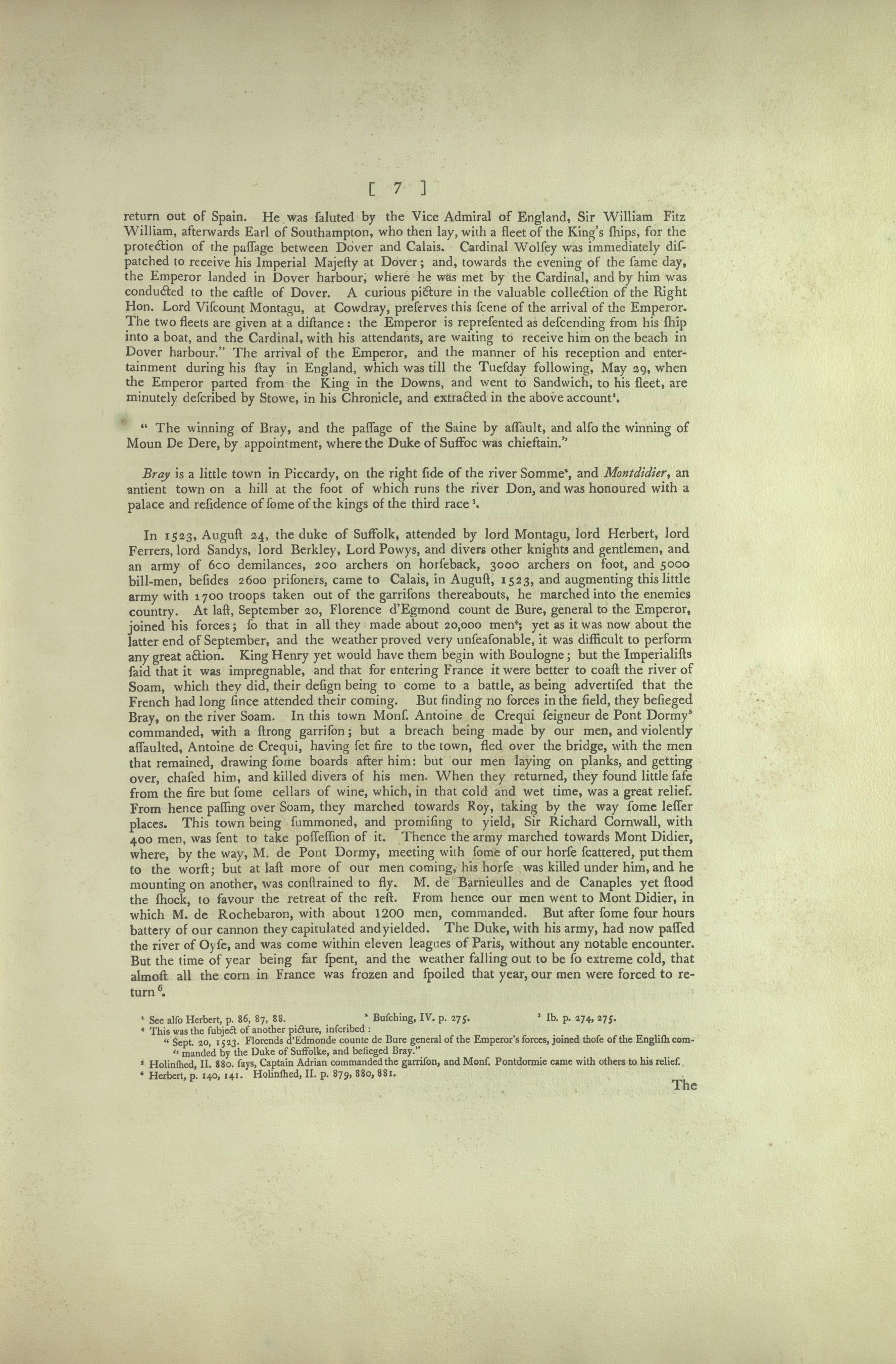
[ (Page) 7]
return out of Spain. He was saluted by the Vice Admiral of England, Sir William Fitz Willam, afterwards Earl of Southampton, who then lay, with a fleet of the King’s ships, for the protection of the passage between Dover and Calais. Read more/less...
Cardinal Wolsey was immediately dispatched to receive his Imperial Majesty at Dover; and, towards the evening of the same day, the Emperor landed in Dover harbour, where he was met by the Cardinal, and by him was conducted to the castle of Dover. A curious picture in the valuable collection of the Right Hon. Lord Viscount Montagu, at Crowdray, preserves this scene of the arrival of the Emperor. The two fleets are given at a distance: the Emperor is represented as descending from his ship into a boat, and the Cardinal, with his attendants, are waiting to receive him on the beach in Dover harbour.” The arrival of the Emperor, and the manner of his reception and entertainment during his stay in England, which was till the Tuesday following, May 29, when the Emperor parted from the King in the Downs, and went to Sandwich, to his fleet, are minutely described by Stowe, in his Chronicle, and extracted in the above account1.
“The winning of Bray, and the passage of the Saine by assault, and also the winning of Moun De Dare, by appointment, where the Duke of Suffoc was chieftain.”
Bray is a little town in Piccardy on the right side of the river Somme2, and Montdidier, an antient town on a hill at the foot of which runs the river Don, and was honored with a palace and residence of some of the kings of the third race3.
In 1523, August 24, the duke of Suffolk, attended by lord Montagu, lord Herbert, lord Ferrers, lord Sandys, lord Berkley, Lord Powys, and divers other knights and gentlemen, and an army of 600 demilances, 200 archers on horseback, 3000 archers on foot, and 5000 bill-men, besides 2600 prisoners, came to Calais, in August, 1523, and augmenting this little army with 1700 troops taken out of the garrisons thereabouts, he marched into the enemies country. At last, September 20, Florence d’Egmond count de Bure, general to the Emperor, joined his forces; so that in all they made about 20,000 men4; yet as it was now about the latter end of September, and the weather proved very unseasonable, it was difficult to perform any great action. King Henry yet would have them begin with Boulogne; but the imperialists said that it was impregnable, and that for entering France it were better to coast the river of Soam, which they did, their design being to come to a battle, as being advertised that the French had long since attended their coming. But finding no forces in the field, they besieged Bray, on the river Soam. In this town Mons. Antoine de Crequi seigneur de Pont Dormy5 commanded, with a strong garrison; but a breach being made by our men, and violently assaulted, Antoine de Crequi, having set fire to the town, fled over the bridge, with the men that remained, drawing some boards after him: but our men laying on planks, and getting over, chased him, and killed divers of his men. When they returned, they found little safe from the fire but some cellars of wine, which, in that cold and wet time, was a great relief. From hence passing over Soam, they marched towards Roy, taking by the way some lesser places. This town being summoned, and promising to yield, Sir Richard Cornwall, with 400 men, was sent to take possession of it. Thence the army marched towards Mont Didier, where, by the way, M. De Pont Dormy, meeting with some of our horse scattered, put them to the worst; but at last more of our men coming, his horse was killed under him, and he mounting on another, was constrained to fly. M. de Barnieulles and de Canaples yet stood the shock, to favor the retreat of the rest. From hence our men went to Mont Didier, in which M. de Rochebaron, with about 1200 men, commanded. But after some four hours battery of our cannon they capitulated and yielded. The duke, with his army, had now passed the river of Oyse, and was come within eleven leagues of Paris, without any notable encounter. But the time of year being far spent, and the weather falling out to be so extreme cold, that almost all the corn in France was frozen and spoiled that year, our men were forced to return6.
1 See also Herbert, p. 86, 87, 88.
2 Busching, IV. p. 275.
3 Ib. p. 274, 275.
4 This was the subject of another picture, inscribed:
“Sept. 20, 1523. Florends d’Edmond counte de Bure general of the Emperor’s forces, joined those of the English commanded by the Duke of Suffolke, and besieged Bray.”
5 Holinshed, II. 880. says, Captain Adrian commanded the garrison, and Mons. Pontdormie came with others to his relief.
6 Herbert, p. 140, 141. Holinshed, II. p. 879, 880, 881.
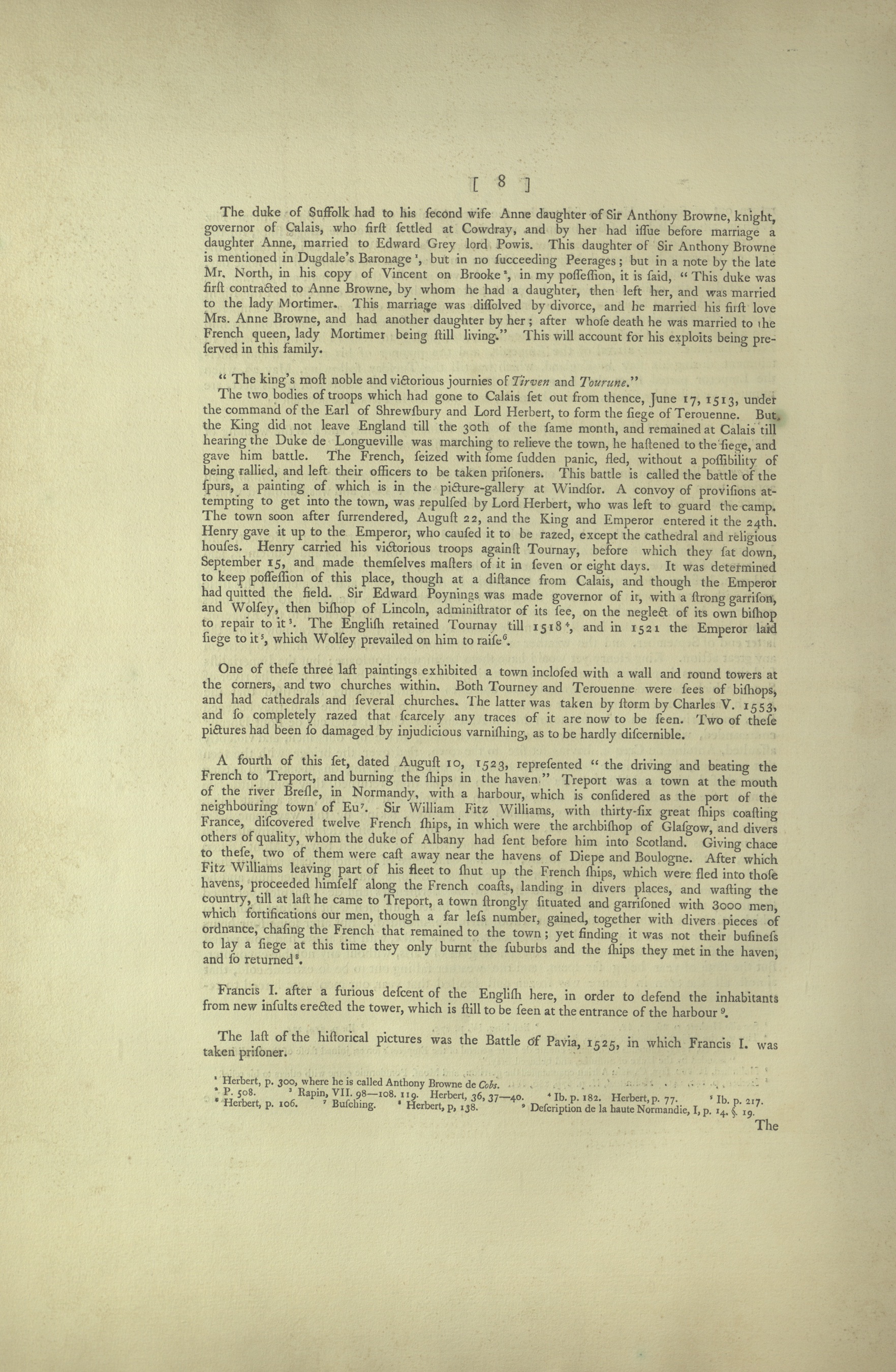
[ (Page) 8 ]
The duke of Suffolk had to his second wife Anne daughter of Sir Anthony Browne, knight, governor of Calais, who first settled at Cowdray, and by her had issue before marriage a daughter Anne, married to Edward Grey lord Powis.
Read more/less...
This daughter of Sir Anthony Browne is mentioned in Dugdale’s Baronage1, but in no succeeding Peerages; but in a note by the late Mr. North, in his copy of Vincent on Brooke2, in my possession, it is said, “This duke was first contracted to Anne Browne, by whom he had a daughter, then left her, and was married to the lady Mortimer. This marriage was dissolved by divorce, and he married his first love Mrs. Anne Browne, and had another daughter by her; after whose death he was married to the French queen, lady Mortimer being still living.” This will account for his exploits being preserved in this family.
“The king’s most noble and victorious journeys of Tirven and Tourune.”
The two bodies of troops which had gone to Calais set out from thence, June 17, 1513, under the command of the Earl of Shrewsbury and Lord Herbert, to form the siege of Terouenne. But the King did not leave England till the 30th of the same month, and remained at Calais till hearing the Duke de Longueville was marching to relieve the two, he hastened to the siege, and gave him battle. The French, seized with some sudden panic, fled, without a possibility of being rallied, and left their officers to be taken prisoners. This battle is called the battle of the spurs, a painting of which is in the picture-gallery at Windsor. A convoy of provision attempting to get into the town, was repulsed by Lord Herbert, who was left to guard the camp. The town soon after surrender, August 22, and the King and Emperor entered it the 24th. Henry gave it up to the Emperor, who caused it to be razed, except the cathedral and religious houses. Henry carried his victorious troops against Tournay, before which they sat down, September 15, and made themselves masters of it in seven or eight days. It was determined to keep possession of this place, though at a distance from Calais, and though the Emperor had quitted the field. Sir Edward Poynings was made governor of it, with a strong garrison, and Wolsey, then bishop of Lincoln, administrator of its see, on the neglect of its own bishop to repair to it5, which Wolsey prevailed on him to raise6.
One of these three last paintings exhibited a town inclosed with a wall and round towers at the corners, and two churches within. Both Tourney and Terouenne were sees of bishops, and had cathedrals and several churches. The latter was taken by storm by Charles V. 1553, and so completely razed that scarcely any traces of it are now to be seen. Two of these pictures had been so damaged by injudicious varnishing, as to be hardly discernible.
A fourth of this set, dated August 10, 1523, represented “the driving and beating the French to Treport, and burning the ships in the haven.” Treport was a town at the mouth of the river Bresle, in Normandy, with a harbour, which is considered as the port of the neighboring town of Eu7. Sir William Fitz Williams, with thirty-six great ships coasting France, discovered twelve French ships, in which were the archbishop of Glasgow, and divers others of quality, whom the duke of Albany had sent before him into Scotland. Giving chace to these, two of them were cast away near the havens of Diepe and Boulogne. After which Fitz Williams leaving part of his fleet to shut up the French ships, which were fled into those havens, proceeded himself along the French coasts, landing in divers places, and wasting the country, till at last he came to Treport, a town strongly situated and garrisoned with 3000 men, which fortifications our men, though a far less number, gained, together with divers pieces of ordnance, chasing the French that remained to the town; yet finding it was not their business to lay a siege at this time they only burnt the suburbs and the ships they met in the haven, and so returned8.
Francis I. After a furious descent of the English here, in order to defend the inhabitants from new insults erected the tower, which is still to be seen at the entrance of the harbour9.
The last of the historical pictures was the Battle of Pavia, 1525, in which Francis I. was taken prisoner.
1 Herbert, p. 300, where he is called Anthony Browne de Cobs.
2 P. 508
3 Rapin, VII. 98-108. 119. Herbert, 36, 37-40.
4 Ib. p. 182. Herbert, p. 77.
5 Ib. p. 217.
6 Herbert, p. 106.
7 Busching.
8 Herbert, p, 138.
9 Description de la haute Normandie, I, p. 14. 19.
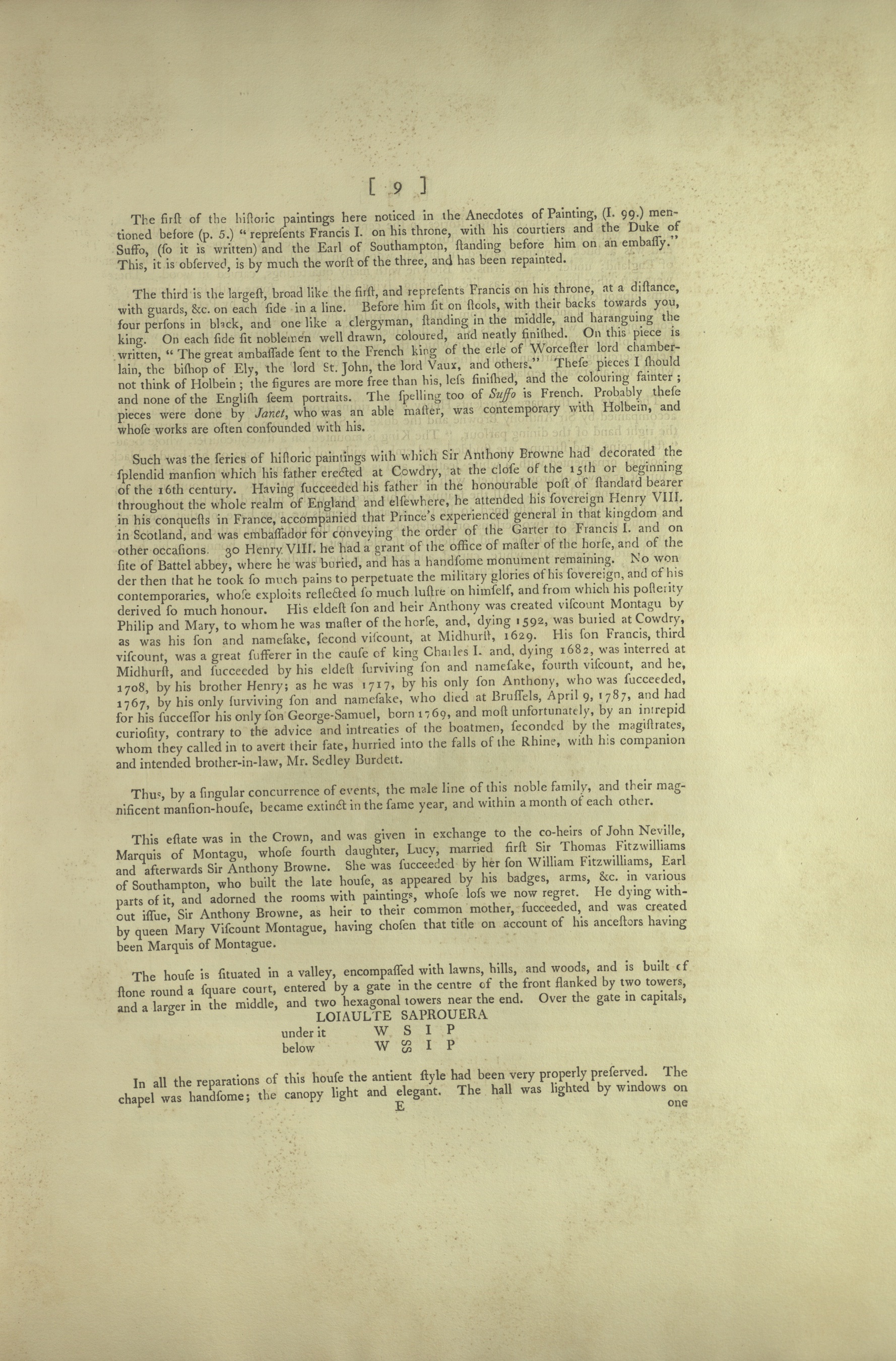
[ (Page) 9 ]
The first of the historic paintings here noticed in the Anecdotes of Painting, (I. 99.) mentioned before (p. 5.) “represents Francis I. on his throne, with his courtiers and the Duke of Suffo, (so it is written) and the Earl of Southampton, standing before him on an embassy.” This, it is observed, is by much the worst of the three, and has been repainted.
Read more/less...
The third is the largest, broad like the first, and represents Francis on his throne, at a distance, with guards, &c. on each side in a line. Before him sit on stools, with their backs towards you, four persons in black, and one like a clergyman, standing in the middle, and haranguing the king. On each side sit noblemen well drawn, colored, and neatly finished. On this piece is written, “The great ambassade sent to the French king of the erle of Worcester lord chamberlain, the bishop of Ely, the lord St. John, the lord Vaux, and others.” These pieces I should not think of Holbein; the figures are more free than his, less finished, and the coloring fainter; and none of the English seem portraits. The spelling too of Suffo is French. Probably these pieces were done by Janet, who was an able master, was contemporary with Holbein, and whose works are often confounded with his.
Such was the series of historic paintings with which Sir Anthony Browne had decorated the splendid mansion which his father erected at Cowdry, at the close of the 15th or beginning of the 16th century. Having succeeded his father in the honorable post of standard bearer throughout the whole realm of England and elsewhere, he attended his sovereign Henry VIII. in his conquests in France, accompanied that Prince’s experienced general in that kingdom and in Scotland, and was ambassador for conveying the order of the Garter to Francis I. and on other occasions. 30 Henry VIII. He had a grant of the office of master of the horse, and of the site of Battel abby, where he was buried, and has a handsome monument remaining. No wonder then that he took so much pains to perpetuate the military glories of his sovereign, and of his contemporaries, whose exploits reflected so much lustre on himself, and from which his posterity derived so much honour. His eldest son and heir Anthony was created viscount Montague by Philip and Mary, to whom he was master of the horse, and, dying 1592, was buried at Cowdry, as was his son and namesake, second viscount at Midhurst, 1629. His son Francis, this viscount, was a great sufferer in the cause of King Charles I. and, dying 1682, was interred at Midhurst, and succeeded by his eldest surviving son and namesake, fourth viscount, and he, 1708, by his brother Henry; as he was 1717, by his only son Anthony, who was succeeded, 1767, by his only surviving son and namesake, who died at Brussels, April 9, 1787, and had for his successor his only son George-Samuel, born 1769, and most unfortunately, by an intrepid curiosity, contrary to the advice and entreaties of the boatmen, seconded by the magistrates, whom they called in to avert their fate, hurried into the falls of the Rhine, with his companion and intended brother-in-law, Mr. Sedley Burdett.
Thus, by a singular concurrence of events, the male line of this noble family, and their magnificent mansion-house, became extinct in the same year, and within a month of each other.
This estate was in the Crown, and was given in exchange to the co-heirs of John Neville, Marquis of Montagu, whose fourth daughter, Lucy, married first Sir Thomas Fitzwilliams and afterwards Sir Anthony Browne. She was succeeded by her son William Fitzwilliams, Earl of Southampton, who built the late house, as appeared by his badges, arms, &c. in various parts of it, and adorned the rooms with paintings, whose loss we now regret. He dying without issue, Sir Anthony Browne, as heir to their common mother, succeeded, and was created by queen Mary Viscount Montague, having chosen that title on account of his ancestors having been Marquis of Montague.
The house is situated in a valley, encompassed with lawns, hills, and woods, and is built of stone round a square court, entered by a gate in the centre of the front flanked by two towers, and a larger in the middle, and two hexagonal towers near the end. Over the gate in capitals,
LOIAULTE SAPROUERA
under it WSIP
below WSSIP
In all the reparations of this house the antient style had been very properly preserved. The chapel was handsome; the canopy light and elegant. The hall was lighted by windows on < br/>
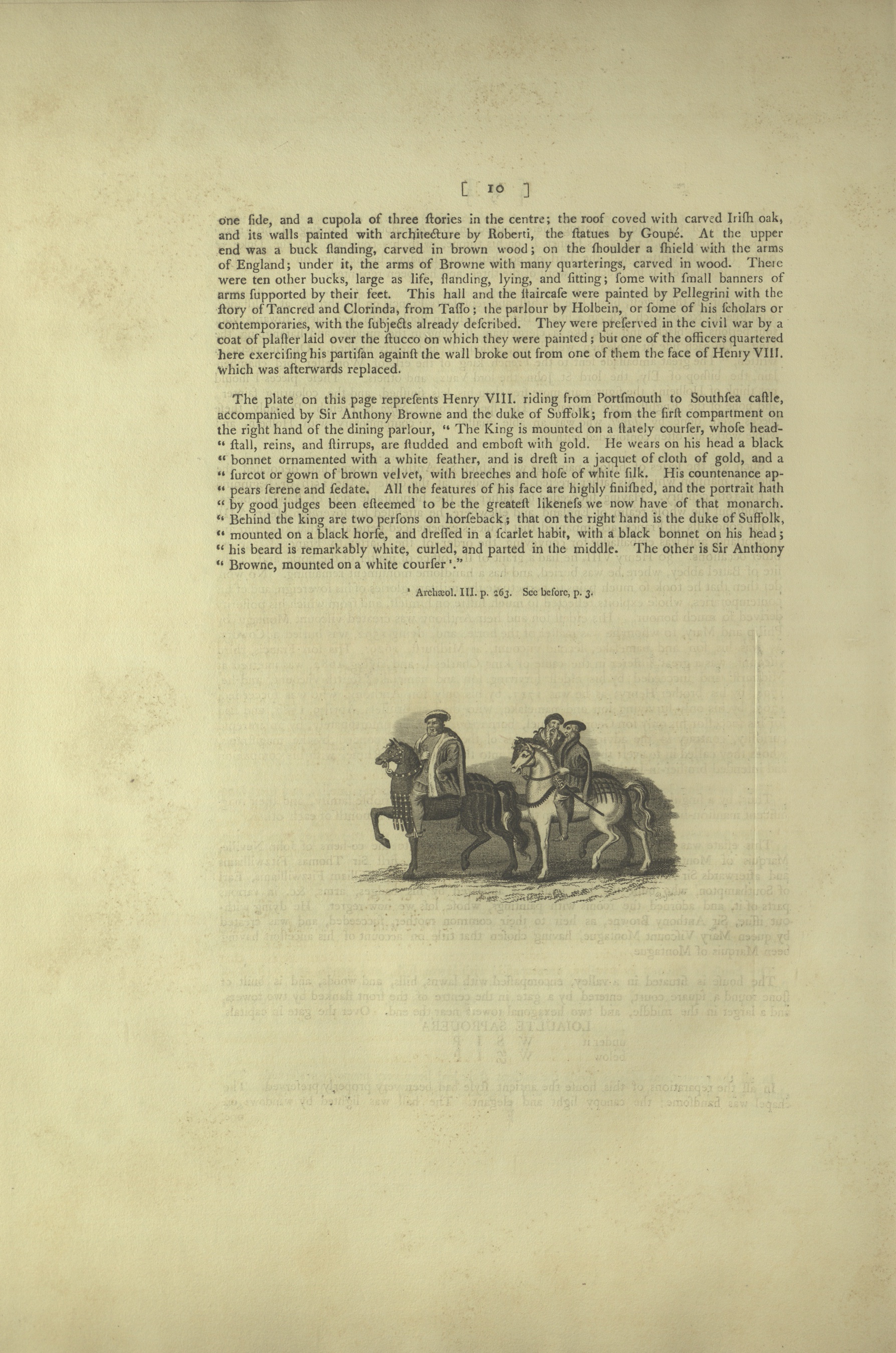
[ (Page) 10 ]
one side, and a cupola of three stories in the centre; the roof coved with carved Irish oak, and its walls painted with architecture by Robert, the statues by Goupé. At the upper end was a buck standing, carved in brown wood; on the shoulder a shield with the arms England; under it, the arms of Browne with many quarterings, carved in wood.
Read more/less...
There were ten other bucks, large as life, standing, lying and sitting; some with small banners of arms supported by their feet. This hall and the staircase were painted by Pellegrini with the story of Tancred and Clorinda, from Tasso ; the parlour by Holbein, or some of his scholars or contemporaries, with the subject already described. They were preserved in the civil war by a coat of plaster laid over the stucco on which they were painted ; but one of the officers quartered here exercising his partisan against the wall broke out from one of them the face of Henry VIII. which was afterwards replaced.
The plate on this page represents Henry VIII. riding from Portsmouth to Southsea castle, accompanied by Sir Anthony Browne and the duke of Suffolk; from the first compartment on the right hand of the dining parlour, “The King is mounted on a stately courser, whose head stall, reins, and stirrups, are studded and embost with gold. He wears on his head a black bonnet ornamented with a white feather, and is drest in a jacquet of cloth of gold, and a furcot or gown of brown velvet, with breeches and hose of white silk. His countenance appears serene and sedate. All the features of his face are highly finished, and the portrait hath by good judges been esteemed to be the greatest likeness we now have of that monarch. Behind the king are two persons on horseback; that on the right hand is the duke of Suffolk, mounted on a black horse, and dressed in a scarlet habit, with a black bonnet on his head; his beard is remarkably white, curled, and parted in the middle. The other is Sir Anthony Browne, mounted on a white courser1.”
1 Archaeol. III. p. 263. See before, p. 3.
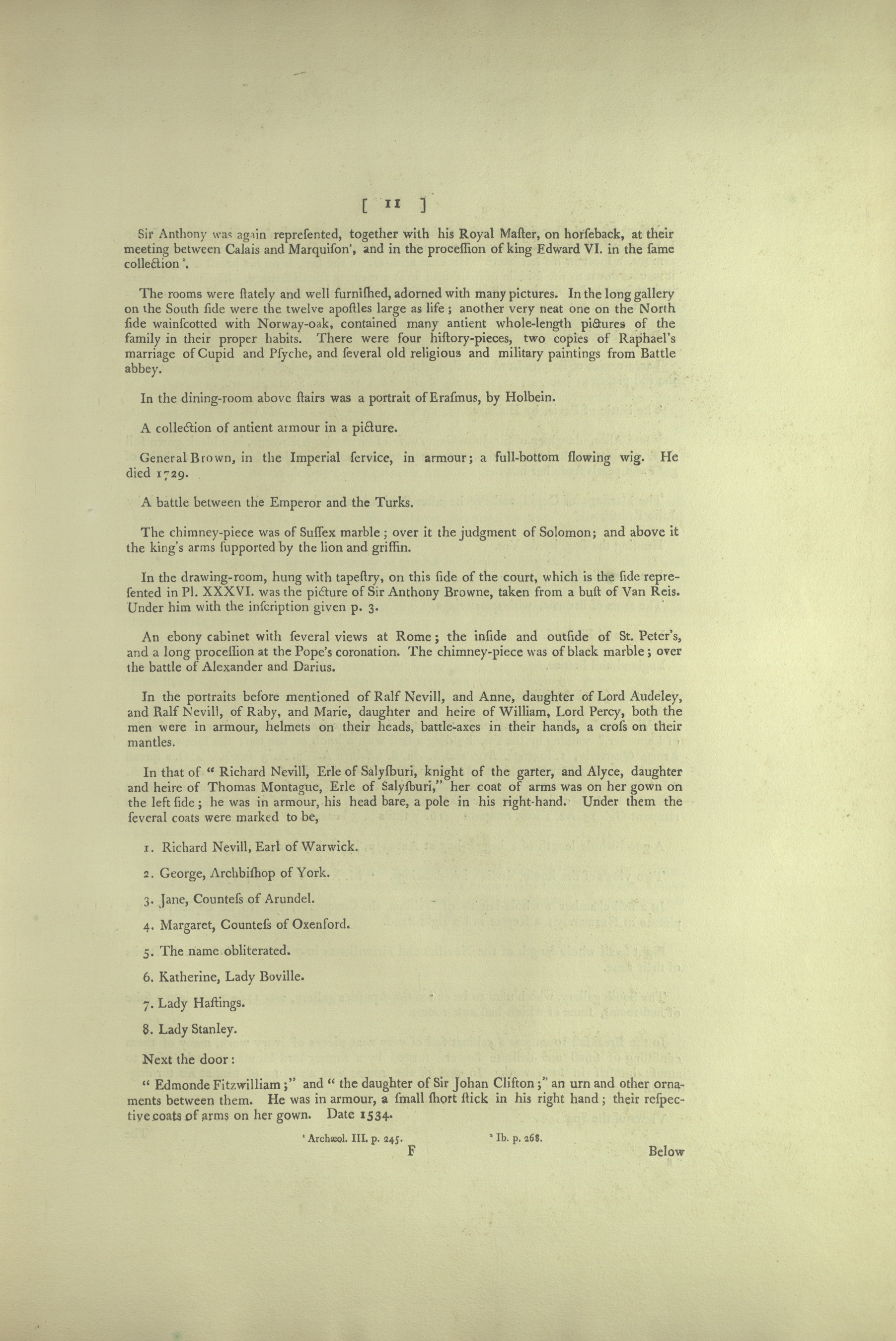
[ (Page) 11 ]
Sir Anthony was again represented, together with his Royal Master, on horseback, at their meeting between Calais and Marquison’, and in the procession of king Edward VI. in the same collection1.
Read more/less...
The rooms were stately and well furnished, adorned with many pictures. In the long gallery on the South side were the twelve apostles large as life ; another very neat one on the North Side wainscotted with Norway-oak, contained many ancient whole-length pictures of the family in their proper habits. There were four history-pieces, two copies of Raphael’s marriage of Cupid and Psyche, and several old religious and military paintings from the Battle abbey.
In the dining-room above stairs was a portrait of Erasmus, by Holbein.
A collection of antient armour in a picture.
General Brown, in the Imperial service, in armour ; a full-bottom flowing wig. He died 1729.
A battle between the Emperor and the Turks.
The chimney-piece was of Sussex marble ; over it the judgment of Solomon; and above it the king’s arms supported by the lion and griffin.
In the drawing-room, hung with tapestry, on the side of the court, which is the side represented in PI. XXXVI. was the picture of Sir Anthony Browne, taken from a bust of Van Reis. Under him with the inscription given p.3.
An ebony cabinet with several views at Rome ; the inside and outside of St. Peter’s, and a long procession at the Pope’s coronation. The chimney-piece was a black marble ; over the battle of Alexander and Darius.
In the portraits before mentioned of Ralf Nevill, and Anne, daughter of Lord Audley, and Ralf Nevill, of Raby, and Marie, daughter and heire of William, Lord Percy, both the men were in armour, helmets on their heads, battle-axes in their hands, and a cross on their mantles.
In that of “ Richard Nevill, Erle of Salysburi, knight of the garter, and Alyce, daughter and heire of Thomas Montague, Erle of Salysburi,” her coat of arms was on her gown on the left side ; he was in armour, his head bare, a pole in his right-hand. Under them the several coats were marked to be,
1. Richard Nevill, Earl of Warwick.
2. George, Archbishop of York.
3. Jane, Countess of Arundel.
4. Margaret, Countess of Oxenford.
5. The name obliterated.
6. Katherine, Lady Boville.
7. Lady Haftings.
8. Lady Stanley.
Next the door:
“Edmonde Fitzwilliam;” and “the daughter of Sir Johan Clifton;” an urn and other ornaments between them. He was in armour, a small short stick in his right hand ; their respective coats of arms on her gown. Date 1534.
1 Archaeol. III. P. 245. 2 Ib. p. 268.

[ (Page) 12 ]
Below was another picture of the same person, and of “ Maulde, daughter of Johan Hotham, of Holtherness:” an urn between them as above. Date 1534. He was here also in armour, a spear in his left-hand.
Read more/less...
His coat armour, in the first, is on his breast only; in this, it reaches down to the middle of his thigh; in it a crescent for difference. The upper picture had no beard; but his had. Their coats of arms were on the lady’s gown. Her arms were : Or, on a bend Sable three stars Az. pierced.
In the North gallery:
Large copies of Ralph, Lord Nevill, and the daughter of Lord Percy, and of some other of the old pictures.
The battle of Pavia, by Holbein.
Dame Alice, daughter of Sir John Gage, wife of Sir Anthony Browne, in a black gown full of long points on the arms, breast, and to the bottom; gold border to her ruff ; a chain of gold and pearls from her neck.
The Marriage of Cupid and Psyche after Raphael, and above it the council of Gods by Julio Romano.
Hunting the stag, by de Vos.
In a bow window :
The arms of Browne, with quarterings.
France and England.
England and France.
Another (qu. Fitzwilliam?)
“William Fitz William Earl of Southhampton, lord preve seal and chauncellor of the Duchy of Lancaster,” walking by the sea, holding a staff with a knob on the top; the face very fine. Arms; Quarterly, 1. lozenge, Arg. and S. 2. S a saltire A. 3. A. 3 suzils. 4. O. a spread eagle G. 5. S. 3 martlets O. 6. Az. a bend O. under a file of 3 A. 7 G. in a bordure A. 3 lions passant guardant O. 8. a saltire ingrailed S. 9. S. a cross A. 10. A on a canton a bend. 11. A 3 gerbes among cross crosslets. 12. A. . . fusils in bends S. 14. a lion rampant G. 15. Az. a lion rampant. 16. 3 fusils S. 3. bezants.
A good whole length of a beggar-boy at Antwerp, by P. Snyders.
Two views of the house, Indian ink drawings. “M. Xhrouruet fecit [Made by M. Xhrouruet], 1736.”
In a bed-chamber a whole-length of William the Conqueror, said to be copied from a picture in Normandy ; a sceptre in his right-hand.
Eight small whole length the Nevilles and Fitzwilliams in pairs by Holbein, in the habits of their time.
The South gallery, which used to be called the Apostles gallery, was 1784 made into a suite of bed-rooms, some of which had ante-rooms.
In the Breakfast-room was a cabinet full of very neat pieces of ivory work, many of them consisting of small and delicate flowers, turned by a former lord Montacute, who used to amuse himself in such work. In one of the rooms was a picture of him at his turning-wheel.
Views of the Spa.
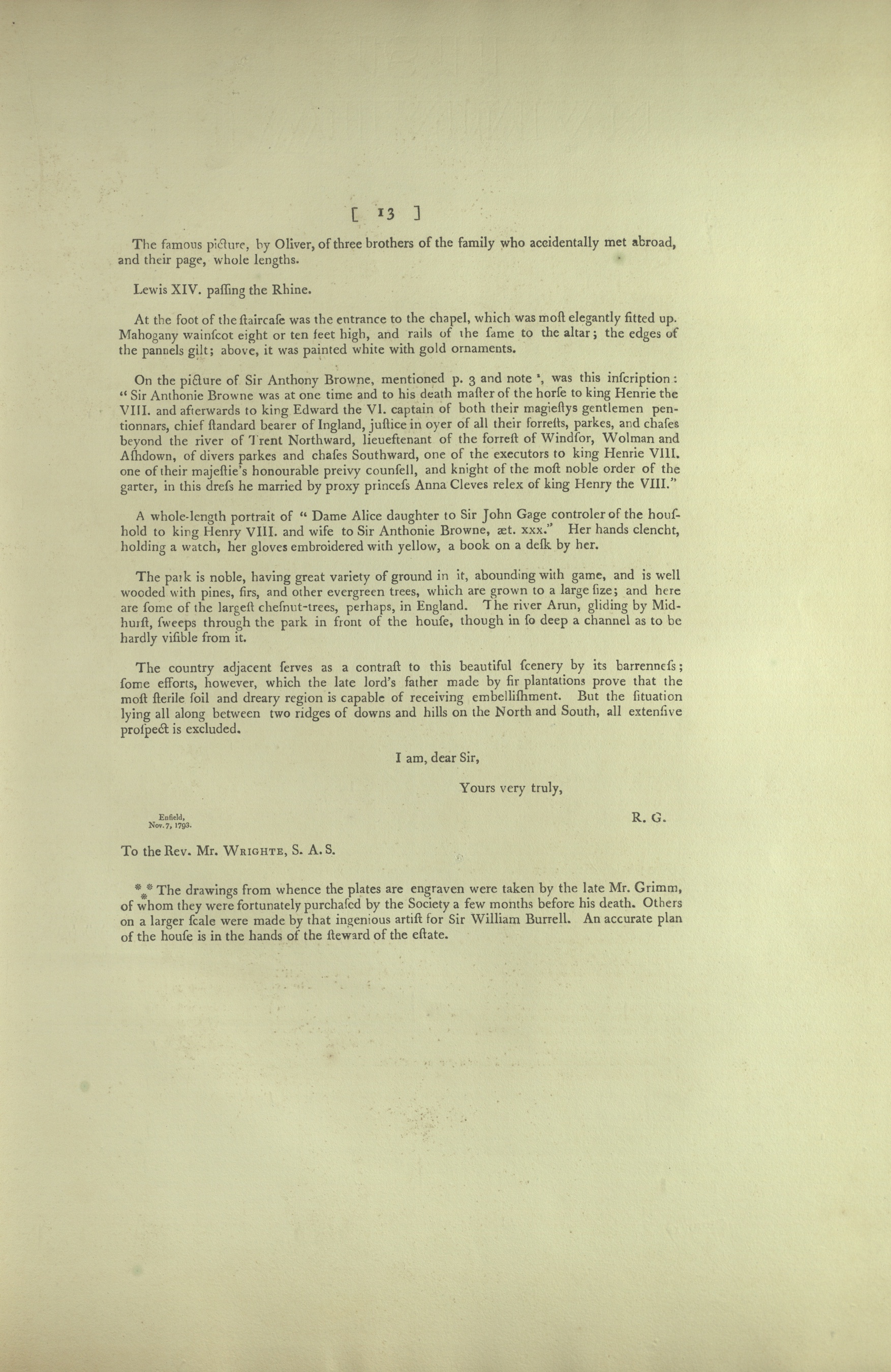
[ (Page) 13 ]
The famous picture, by Oliver, of three brothers of the family who accidentally met abroad, and their page, whole lengths.
Lewis XIV. passing the Rhine.
Read more/less...
At the foot of the staircase was the entrance to the chapel, which was most elegantly fitted up. Mahogany wainscot eight or ten feet high, and rails of the same to the altar; the edges of the pannels gilt; above, it was painted white with gold ornaments.
On the picture of Sir Anthony Browne, mentioned p. 3 and note2, was this inscription: “Sir Anthonie Browne was at one time and to his death master of the horse to king Henrie the VIII. and afterwards to king Edward the VI. captain of both their magiestys gentlemen pentionnars, chief standard bearer of Ingland, justice in oyer of all their forrests, parkes, and chases beyond the river of Trent Northward, lieutenant of the forrest of Windsor, Wolman and Ashdown, of divers Parkes and chases Southward, one of the executors to king Henrie VIII. one of their majestie’s honorable preivy counsell, and knight of the most noble order of the garter, in this dress he married by proxy princess Anna Cleves relex of king Henry the VIII.”
A whole-length portrait of “Dame Alice daughter to Sir John Gage controler of the household to king Henry VIII. and wife to Sir Anthonie Browne, aet. xxx.” Her hands clencht, holding a watch, her gloves embroidered with yellow, a book on a desk by her.
The park is noble, having great variety of ground in it, abounding with game, and is well wooded with pines, firs, and other evergreen trees, which are grown to a large size; and here are some of the largest chestnut-trees, perhaps, in England. The river Arun, gliding by Mid-hurst, sweeps through the park in front of the house, though in so deep a channel as to be hardly visible from it.
The country adjacent serves as a contrast to this beautiful scenery by its barrenness; some efforts, however, which the late lord’s father made by fir plantations prove that the most sterile soil and dreary region is capable of receiving embellishment. But the situation lying all along between two ridges of downs and hills on the North and South, all extensive prospect is excluded.
Yours very truly,
R.G. [Richard Gough]
Enfield,
Nov. 7, 1793
To the Rev. Mr. Wrighte, S. A. S.
* * * The drawings from whence the plates are engraved were taken by the late Mr. Grimm, of whom they were fortunately purchased by the Society a few months before his death. Others on a larger scale were made by that ingenious artist for Sir William Burrell. An accurate plan of the house is in the hands of the steward of the estate.